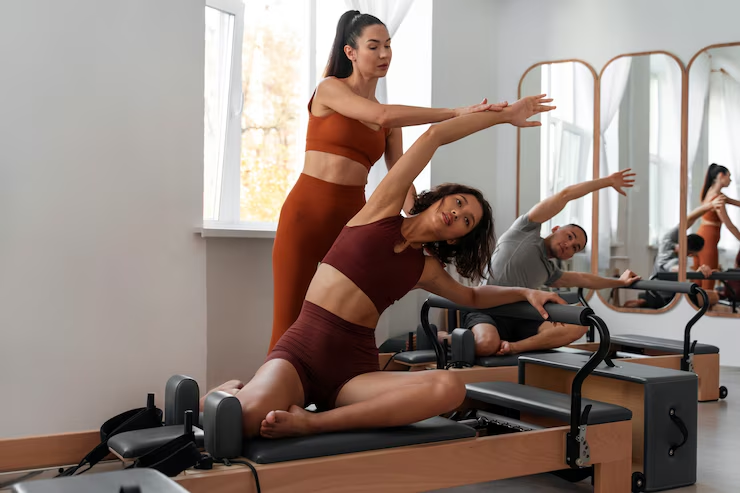What is Double Angle Pose, or Dwikonasana, and What Are Its Advantages? One of the many yoga poses that involves bending the head downward is called Dwikonasana. This pose promotes better blood flow to the brain, which has numerous mental health benefits. The rejuvenating effects of this pose are its main advantage.
Because of the pressures of modern life and the demands of the workplace, stress has become a common mental health issue in modern society. Stress affects approximately 89% of Indians, more than the 86% average for the world. Indians are said to lead the most stressful lives by researchers. More and more evidence points to the negative health effects of stress and the need to reduce it. Numerous asanas, or positions, can help you decompress and revitalize your body and mind. Pose with many healing benefits, Dwikonasna is one of the easiest. One can be revitalized and release tension from their body in a matter of minutes. We will concentrate on what Dwikonasa is here. What are the advantages? how should it be done? Its variations, contradictions, and safety measures. So let us begin by defining Dwikonasana in order to understand all of this information.
What is Dwikonasana (Double Angle Pose)
A basic standing yoga pose that bends forward and simultaneously stretches the upper and lower bodies is called Dwikonasana. The Sanskrit term Dwikonasana is derived from three words, Dwi+kona+asana, and it means as follows:
Do you want to visit Char Dham? Char Dham Travel Agent is the best place to plan your Char Dham tour. You can book the tour from here.
- Dwi – two
- Kona – angle
- Asana – pose or posture
Pronounce Dwikonasana as dvee-kohn-ash-anna.
A quick break in the office or in between exams can be used to practice the Dwikonasna, a straightforward standing pose. It is helpful to practice it along with other asanas as soon as you wake up. It fortifies the muscles of the neck, chest, and area between the shoulder blades and upper spine. Growing bodies is especially beneficial. Additionally, Dwikonasana can improve memory and concentration by improving blood flow to the brain. The sensation of revitalization is closely linked to these advantages. These are all very important advantages that can make anyone’s life better. If you practice Dwikonasana for a short period of time every day, you can reap many benefits from it. So, let’s discuss the benefits of Dwikonasana.
Benefits of Dwikonasana (Double Angle Pose)
The Dwikonasana or double angle pose has numerous health benefits as we discussed above, some of them are listed below as follows:
Would you like to visit Indiar? A tour operator in India is the best place to plan your tour. You can book a tour from here.
- Reduce Stress
- Stretch Chest Muscles
- Strengthen Arms
- Relief Lower Back Pain
- soothes the muscles in the face
- Increase Hands Dexterity
- Treat Carpal Tunnel Syndrome
- Opens-up Coronary Arteries
- Burn Belly Fat
- Increase Breast Size
- Improve Mobility
Now, discuss in detail how we get these benefits by practicing Dwikonasana or Double angle pose are as follows:
- Reduce Stress
Because the head is bowed in Dwikonasana, the brain receives improved blood flow, and the mind is cooled, which lowers stress.
- Stretch Chest Muscles
By extending the chest muscles in Dwikonasana, heart disease and lung conditions can be lessened.
Would you like to visit Haridwar? Travel agents in Haridwar are the best place to plan your trip. You can book your tour right here.
- Strengthen Arms
By stretching the shoulders, Dwikonasana strengthens the upper arms and increases the flexibility of the shoulder joints.
- Relief Lower Back Pain
Because Dwikonasana stretches the entire spinal cord, it can be used to relieve lower back pain.
- Massages the Face Muscles
By increasing blood flow to the head, the Dwikonasana pose massages the face’s muscles and contributes to better skin texture and increased radiance.
- Increase Hands Dexterity
When you practice Dwikonasana, your wrists and fingers become more flexible, which increases your hand dexterity.
- Treat Carpal Tunnel Syndrome
By stretching and massaging the hand and wrist muscles, Dwikonasana is used as a treatment for carpal tunnel syndrome.
- Opens-up Coronary Arteries
In addition, Dwikonasna practice helps people with high cholesterol levels by widening their coronary arteries.
- Burn Belly Fat
Regular Dwikonasna practice helps to stretch the entire body and massage the abdomen, which helps to reduce belly fat and manage weight.
- Increase Breast Size
Frequent Exercise Dwikonasna gives the upper body a stretch that can enlarge the breasts.
- Improve Mobility
Frequent practice of Dwikonasna improves mobility and relieves stiffness in the neck and upper back by strengthening the muscles across the shoulder blades and upper spine.
When done regularly and according to the recommended methods listed below, the Dwikonasana poses physical and mental benefits.
How To Do Dwikonasana ( Double Angle Pose)
Dwikonasana, also known as double angle pose, instructions for beginners, warm-ups, release techniques, length, variations, safety measures, and contraindications to the pose are all included. So, let’s start with beginner tips.
Beginners Tips for Dwikonasana ( Double Angle Pose)
The following are some beginner’s pointers for Dwikonasana, also known as double angle pose, to bear in mind while executing the pose:
- Beathe Slowly during Dwikonasana’s entire process.
- If your back is stiff, keep your knees bent. Your lower back and hamstrings will feel better as a result.
- Bending the body during Dwikonasana, bring the trunk parallel to the floor.
- Use a towel if you find it difficult to hold your arms together for an extended amount of time.
- Avoid overstretching your muscles.
Preparatory Poses for Dwikonasana (Double Angle Pose)
The following poses can be used as warm-ups for Dwikonasana, also known as double angle pose:
- Tadasana – Mountain Pose
- Adho Mukha Svanasana – Downward Facing Dog
Steps for Dwikonasana (Double Angle Pose)
The steps to correctly perform Dwikonasana, also known as double angle pose, are listed below:
- Remain upright. keep your feet to 2 feet apart.
- Plant the soles of your feet firmly on the ground.
- Put the arms behind you now.
- Keep your fingers together and interlocked on the back.
- Inhale now and lift your head.
- Exhale now and bend your hips and waist forward.
- Make sure your spine stays straight.
- Now, take a slow breath in and raise your arms as high as you can.
- In tandem (with step 8): raise your head and look up.
- Exhale now and gently lower your arms to your back.
- Concurrently (with step 8) turn to face the earth.
- Take a breath now and raise yourself to a standing position. This concludes the Dwikonasana round.
DURATION: Just a few (2–3) seconds are needed to hold the Dwikonasana. Dwikonasana(as in Step 12). Depending on your level, repeat Dwikonasana three to ten times.
Follow-Up Poses of Dwikonasana (Double Angle Pose)
Some counterposes or follow-ups for Dwikonasana, also known as double angle pose, are listed below:
- Chakrasana – Wheel Pose
- Ushtrasana – Camel Pose
Precautions and Contraindications for Dwikonasana (Double Angle Pose)
Before executing Dwikonasana, also known as double angle pose, be aware of the following precautions and contraindications:
- People with shoulder problems should not perform Dwikonasana.
- You should not perform Dwikonasana while pregnant.
- Those with back problems should not perform dwikonasana.
- Those with high blood pressure and vertigo should stay away from Dwikonasana.
- You should not perform Dwikonasana if you have a hernia or a stomach ulcer.
Advance Poses or Variations of Dwikonasana (Double Angle Pose)
The following are some of the more difficult variations of Dwikonasana, also known as double angle pose with base pose, that we will be talking about here:
- Variation 1 (Dandayamana Yoga Mudrasana): In this version, as demonstrated in the picture below, after achieving Dwikonasana, bend your knee slightly and bring your head as close to your knees as you can.
- Variation 2 (Dangling Pose): This variation is identical to Dwikonasana except that it changes only the hand position and the way the arms are interlocked at the elbows.
Dwikonasana Titles in English and Sanskrit
Dwikonasana is one of the many names for certain yoga poses. Thus, the following are some additional titles or names of Dwikonasana in Hindi, English, and Sanskrit:
- Double Angle Pose
- Dandayamana Yoga Mudrasana
- Standing Yoga Seal Pose
- Dvikonasana
- Standing Forward Fold Pose Hands Behind Back
- Standing Seal Pose





